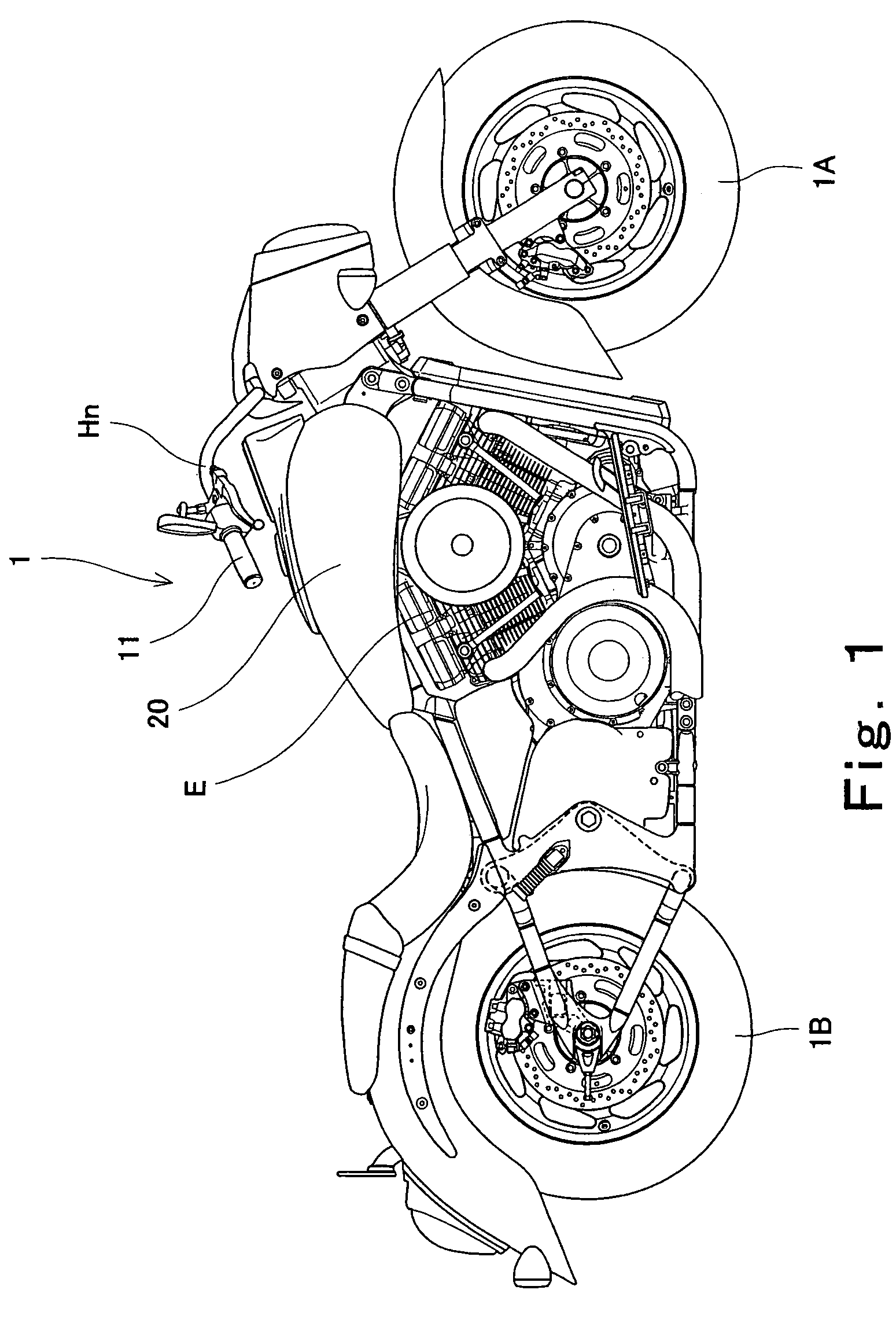Leisure vehicle
a technology for vehicles and sports, applied in the field of sports vehicles, can solve the problems of increased engine braking, difficulty in achieving desired deceleration or engine braking,
- Summary
- Abstract
- Description
- Claims
- Application Information
AI Technical Summary
Benefits of technology
Problems solved by technology
Method used
Image
Examples
embodiment 1
[0045]Turning to FIG. 1, a front wheel 1A of a motorcycle 1 is a non-drive (free) wheel. A front wheel speed sensor unit 2A (see FIG. 2) is attached to the front wheel 1A and is configured to detect a rotational speed of the front wheel 1A. As a power unit to drive the motorcycle 1, a four-cycle internal combustion engine E is disposed below a fuel tank 20. A rear wheel 1B of the motorcycle 1 is a drive wheel configured to be driven by the four-cycle engine E. A rear wheel speed sensor unit 2B (see FIG. 2) is attached to the rear wheel 1B and is configured to detect a rotational speed of the rear wheel 1B.
[0046]As shown in FIG. 2, the front wheel speed sensor unit 2A and the rear wheel speed sensor unit 2B are coupled to a slip sensor unit 2 in a control unit through signals lines L1 and L2, respectively. The slip sensor unit 2 is configured to detect a slip state of the rear wheel 1B based on a ratio of the rotational speed of the front wheel 1A to the rotational speed of the rear ...
embodiment 2
[0084]Instead of or in addition to the configuration of Embodiment 1, a gear change sensor unit 9 (FIG. 2) is attached in an interior of a transmission (not shown) and is configured to detect a gear position change of the transmission. The gear change sensor unit 9 is communicatively coupled to the controller 60 through a signal line L9. As shown in FIG. 8, the controller 60 is configured to cause the idle stopper operation actuator 6 to operate for a moment, for example, move up by a predetermined amount (corresponding to approximately 800 rpm in terms of the engine speed) to change the position of the idle stopper 3B to open the throttle valve 3B, thus increasing the engine speed, each time the gear position is shifted down. This enables the downshift to smoothly take place. At an upper part of FIG. 8, a vertical axis indicates an opening degree (Th opening degree) of the throttle valve 3A, a position (Ac position) of the idle stopper 3B, and the engine speed (E / G engine speed), a...
embodiment 3
[0085]As shown in FIGS. 10A and 10B, in order to generate a smaller braking force of the engine brake, a dash pot 230 with a stroke length of St is disposed between a fixed part 203f of a throttle device 203 of the engine E and a pivot shaft 203s of a throttle valve 203A of the throttle device 203 or the throttle valve 203A, to be specific, between the fixed part 203f and an engagement portion 203n attached to the pivot shaft 203s of the throttle valve 203A. The dash pot 230 is configured to be contracted slowly because of an internal fluidic resistance and a spring force applied by a compressive spring (not shown) when the throttle valve 203A is moved to a greatest-degree closed position corresponding to an idling engine speed of the engine by a spring force of a return spring (not shown) mounted on the throttle valve 203A (or a force exerted by the throttle valve operation actuator (not shown)), and is configured to be expanded by the spring force of the compressive spring of the ...
PUM
 Login to View More
Login to View More Abstract
Description
Claims
Application Information
 Login to View More
Login to View More - R&D
- Intellectual Property
- Life Sciences
- Materials
- Tech Scout
- Unparalleled Data Quality
- Higher Quality Content
- 60% Fewer Hallucinations
Browse by: Latest US Patents, China's latest patents, Technical Efficacy Thesaurus, Application Domain, Technology Topic, Popular Technical Reports.
© 2025 PatSnap. All rights reserved.Legal|Privacy policy|Modern Slavery Act Transparency Statement|Sitemap|About US| Contact US: help@patsnap.com



